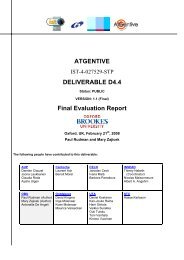Industry Roadmap to Web 3.0 & Multibillion Dollar ... - INSEAD CALT
Industry Roadmap to Web 3.0 & Multibillion Dollar ... - INSEAD CALT
Industry Roadmap to Web 3.0 & Multibillion Dollar ... - INSEAD CALT
You also want an ePaper? Increase the reach of your titles
YUMPU automatically turns print PDFs into web optimized ePapers that Google loves.
Market Trend 4—Enterprise Horizontal<br />
Middleware, services, processes, search, and collaboration go semantic.<br />
As shown in the diagram below, just about everywhere<br />
one can look in an enterprise, someone<br />
somewhere is applying semantic technologies <strong>to</strong><br />
some problem. Drivers of enterprise business value<br />
are all strong— new capability, life cycle ROI,<br />
performance, and strategic edge.<br />
Semantic Wave 2008 examines enterprise markets<br />
for semantic technologies including twelve<br />
categories of commercial-off-the-shelf software<br />
(COTS) packages that are estimated <strong>to</strong> represent<br />
a combined software product and service revenue<br />
of more than $160 billion in 2010. The report<br />
projects the transition of these market segments<br />
from conventional <strong>to</strong> semantic COTS technologies.<br />
Amongst the first tier of large ICT technology<br />
providers, areas that are being targeted first are<br />
related <strong>to</strong> the internal stack, or plumbing for suites<br />
of applications because these changes make few<br />
demands on cus<strong>to</strong>mer while establishing a semantic<br />
application framework that developer can<br />
use as a foundation. Service oriented architecture<br />
becomes semantic SOA. Changes that impact<br />
application concept of operations, and user interface<br />
come next.<br />
Also, enterprise software has a long tail. There are<br />
an estimated 56 million firms worldwide, including<br />
1.5 million with more than 100 employees, and<br />
around 80,000 businesses with more than 1,000<br />
employees. The transition <strong>to</strong> semantic software<br />
technologies will facilitate mass cus<strong>to</strong>mization of<br />
commercial-off-the-shelf solutions enabling software<br />
vendors <strong>to</strong> address more levels of the market<br />
with sustainable solutions.<br />
Below:<br />
What Semantic Technologies Are Being<br />
Employed in Enterprise?<br />
Executive<br />
Summary<br />
22<br />
Defense, Intelligence, sense-making, data &<br />
content integration, question answering,<br />
reasoning, inference, anti-terrorism, security,<br />
business intelligence; decison support<br />
Business Management<br />
Risk management, regula<strong>to</strong>ry compliance,<br />
fraud detection, money laundering,<br />
real-time auditing; crisis and emergency<br />
management: system, network outages; case<br />
management; business continuity<br />
Mergers & acquisitions, data & systems<br />
integration, enterprise architecture,,<br />
on<strong>to</strong>logy-driven information systems,<br />
semantic interoperability, semantic web<br />
services, virtual data center,<br />
PLM platform<br />
Supply chain integration, design,<br />
sourcing optimization, integration &<br />
interoperation, CPFR<br />
Supplier<br />
Input management, capture,<br />
classification, tagging, routing,<br />
data & content consolidation,<br />
data cleaning<br />
Discovery, aggregation,<br />
au<strong>to</strong>-classification, meta-search,<br />
federated query, smart search,<br />
intelligent domain research.<br />
Design advisors, simulation-based<br />
acquisition; virtual manufacturing<br />
Input<br />
R&D<br />
Supplier<br />
Relationship<br />
Management<br />
Human<br />
Resources<br />
Enterprise<br />
Resource<br />
Planning<br />
Finance &<br />
Accounting<br />
Enterprise<br />
Data, Content & Asset<br />
Management<br />
ITC Modernization<br />
Product<br />
Lifecycle<br />
Management<br />
Au<strong>to</strong>mation<br />
Cus<strong>to</strong>mer<br />
Relationship<br />
Management<br />
Logistics<br />
Production Operations<br />
Output<br />
Support<br />
Cus<strong>to</strong>mer service au<strong>to</strong>mation, cus<strong>to</strong>mer<br />
self-service, personalized information<br />
on-demand, 360°-view of cus<strong>to</strong>mer, field<br />
service operations, integrated CRM<br />
Cus<strong>to</strong>mer<br />
Output management, enterprise<br />
publishing platform , au<strong>to</strong>-generation<br />
of content & media, au<strong>to</strong>-language versioning,<br />
cross-media, semantic portals<br />
Dynamic planning, scheduling,, routing,<br />
optimization. Adaptive systems;<br />
Au<strong>to</strong>nomic systems; Au<strong>to</strong>nomous<br />
products/services<br />
Source: Project10X<br />
2007, 2008 Copyright MILLS•DAVIS. All rights reserved
















